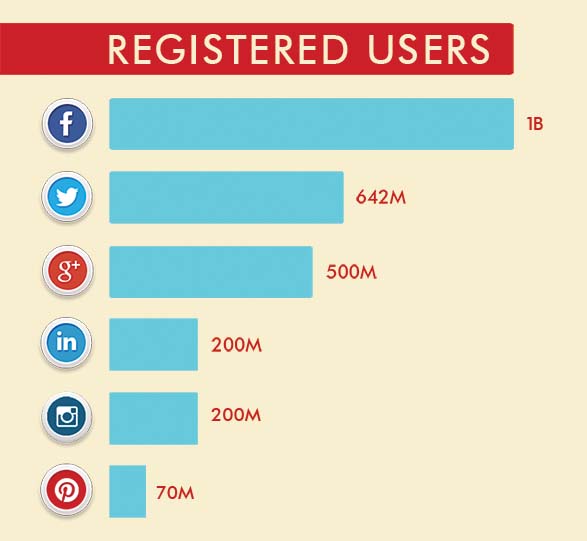
When establishing your marketing strategy, social media should be an active, on-going component. The particular platform may vary based on your industry, but there is an appropriate space for every business or organization. Social media has grown each year since Facebook was founded in 2004, and it continues to successfully reach and engage audiences.
There are several important aspects to consider when establishing a social media strategy, the most important of which is having a proper understanding of each platform to help determine which is most beneficial for your business. You should also enter with a plan; whether this is your first time using social media, or your company is exploring a new platform, a plan will ensure a successful launch that impacts your audience, rather than just causing noise.
So, which is the best platform for your social media strategy? With user groups ranging from 1 billion to 70 million, here are some details on each of the major social media options.

As the most widely used social platform, Facebook offers countless benefits. Of all the options, it has the best advertising feature and offers the most options for communication, from simple posts to surveys. Facebook is regularly one of the top referrers to websites, meaning it is effective at converting people from your page to your website. It has also has a lot of apps that can easily be integrated to further your reach and it works well with most other social platforms. We consider Facebook to be the hub for your social media strategy.
Remember: Engage your followers with information they may be interested in – don’t inundate them with information on your company every other day; provide supplemental information that is fun, engaging, and informal. You’re not selling here, you’re offering an inside, more informal look at your business.
Known as a micro-blogging system, Twitter allows you to disseminate small pieces of information or quickly respond to comments and questions from your audience. Twitter has been used very effectively by Fortune 500 companies in the retail world and has become an extension of many company’s customer service departments. Twitter isn’t right for everyone; we typically recommend it for clients in the retail industry and rarely for those in more professional industries, such as attorneys or physicians. Twitter is a great space for engaging current clients, but it has less of a potential to reach new clients as say Facebook or even LinkedIn does.
Remember: Your Twitter followers expect answers to their questions, and quickly. You’ll find that a lot of your customers will ask questions based on your service or products, so be sure to have someone assigned to manage your account.
Google+
This platform is Google’s counterpart to Facebook. It also utilizes updates and followers, but it has one strong component going for it that no other social media platform can claim – deep integration with Google search results. The major benefit of this platform, beyond social interaction, is to improve your online ranking with Google. We like to think of Google+ as an extension of your blog, posting keyword rich content with links back to your website. You can even setup Google Authorship, which allows your Google+ account to follow your content.
Remember: If you are working to improve your online ranking with Google, this is a great platform for you, but it will require more technical ability to set it up and integrate it appropriately than say Facebook or some of the other platforms do.
With a tagline of “Relationships Matter,” it makes sense that LinkedIn’s focus would be on helping connect people professionally and assisting in the development of referrals and business networks. With LinkedIn, you have the option of a personal page and a business page, just like you do with Facebook. If you are in a professional field where referrals and networking are important pieces of your growth, we recommend getting familiar and active with LinkedIn. Your strategy should be a patient one, as LinkedIn is about establishing relationships with people who may not have an immediate need, but the goal is to be in the forefront of their mind when that need does arise.
Remember: LinkedIn works both ways – you have to give and receive. If you expect to be successful in this space, you must return the favor – offer referrals, extend endorsements and recommendations to colleagues, and offer your expertise by answering any applicable posts from others.
This platform is all about visual content. Somewhat similar to Pinterest, you are engaging your audience with images and it’s very effective at providing a behind the scenes look at your brand. Through the use of #hashtags, you can extend your message via Instagram’s searching feature and attract new audiences to your product.
Remember: Instagram was the first platform to utilize hashtags to extend reach, and it can be very helpful in attracting people to your feed, but avoid overuse!
With a dedicated following that is rapidly growing, Pinterest is an excellent platform for certain industries. If your industry is visually focused (think interior designers, clothing companies, artists, retailers), Pinterest is worth your strong consideration. With a higher conversion rate of eCommerce sales than Facebook, Pinterest is proving to be very effective at moving people from a social space to a point of sale on your website.
Remember: Get to know your audience, and offer your own products but also create content that is of similar interest. If you’re an interior designer, don’t just create boards of before/after pictures of your work, but include boards on fabrics, travel locations, color inspirations, and more. Engage your audience’s interests on multiple levels.
Ready to Strategize?
If you have questions about which platform is right for you or would like to discuss setting up a social media strategy, give us a call or shoot us an email – we’re glad to share more information and help you get started.

